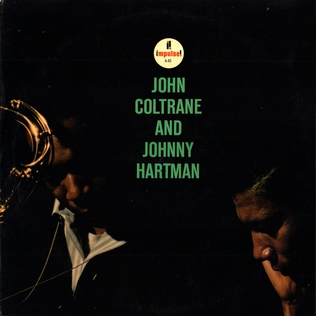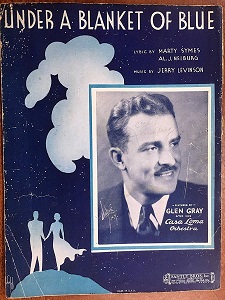Related Research Articles
Gordon Hill Jenkins was an American arranger, composer, and pianist who was influential in popular music in the 1940s and 1950s. Jenkins worked with The Andrews Sisters, Johnny Cash, The Weavers, Frank Sinatra, Louis Armstrong, Judy Garland, Nat King Cole, Billie Holiday, Harry Nilsson, Peggy Lee and Ella Fitzgerald.
"Time After Time" is a romantic jazz standard with lyrics written by Sammy Cahn and music by Jule Styne in 1946.

John Maurice Hartman was an American jazz singer, known for his rich baritone voice and recordings of ballads. He sang and recorded with Earl Hines' and Dizzy Gillespie's big bands and with Erroll Garner. Hartman is best remembered for his collaboration in 1963 with saxophonist John Coltrane, John Coltrane and Johnny Hartman, a landmark album for both him and Coltrane.
"Lush Life" is a jazz standard that was written by Billy Strayhorn from 1933 to 1936. It was performed publicly for the first time by Strayhorn and vocalist Kay Davis with the Duke Ellington Orchestra at Carnegie Hall on November 13, 1948.
"I Should Care" is a popular song with music by Axel Stordahl and Paul Weston and lyrics by Sammy Cahn, published in 1944. Cahn said that the title came to him by the time they played the first 4 bars. It first appeared in the MGM film Thrill of a Romance. The original recording by Ralph Flanagan and His Orchestra, with vocalists: Harry Prime and The Singing Winds was made at Manhattan Center, New York City, on July 18, 1952. It was released by RCA Victor Records as catalog number 20-4885 and by EMI on the His Master's Voice labels as catalog number B 10389.
"But Beautiful" is a popular song with music written by Jimmy Van Heusen, the lyrics by Johnny Burke. The song was published in 1947.

John Coltrane and Johnny Hartman is a studio album by John Coltrane and Johnny Hartman which was released by Impulse! Records in July or August 1963. It was inducted into the Grammy Hall of Fame in 2013.
"Nancy (with the Laughing Face)" is a song composed in 1942 by Jimmy Van Heusen, with lyrics by Phil Silvers, called, originally, "Bessie (With The Laughing Face)". It was originally recorded by Frank Sinatra in 1944. Many, perhaps most, people—including, for a time, Sinatra himself—wrongly assume or assumed the song was composed specifically for Sinatra's wife or daughter, each named Nancy; the adjustment in name indeed was inspired by Sinatra's daughter.
"What's New?" is a 1939 popular song composed by Bob Haggart, with lyrics by Johnny Burke. It was originally an instrumental tune titled "I'm Free" by Haggart in 1938, when Haggart was a member of Bob Crosby and His Orchestra. The tune was written with a trumpet solo, meant to showcase the talents of band-mate Billy Butterfield. Crosby's orchestra recorded "I'm Free" the same day it was written.

Coltrane for Lovers is a compilation album of recordings by American jazz saxophonist-composer John Coltrane, released posthumously on January 23, 2001, by Impulse! and Verve Records. The 11 tracks compiled for the album are all romantic ballads from Coltrane's early years with Impulse!, being recorded during December 1961 to April 1963 at engineer Rudy Van Gelder's recording studio in Englewood Cliffs, New Jersey. Dominated by Coltrane's classic quartet, the sessions also included collaborations with vocalist Johnny Hartman and pianist Duke Ellington.
"I Thought About You" is a 1939 popular song composed by Jimmy Van Heusen with lyrics by Johnny Mercer.
"We'll Be Together Again" is a 1945 popular song composed by Carl T. Fischer, with lyrics by Frankie Laine.

Dedicated to You: Kurt Elling Sings the Music of Coltrane and Hartman is a 2009 live album by Kurt Elling, recorded at the Lincoln Center's American Songbook series.

Swing jazz emerged as a dominant form in American music, in which some virtuoso soloists became as famous as the band leaders. Key figures in developing the "big" jazz band included bandleaders and arrangers Count Basie, Cab Calloway, Jimmy and Tommy Dorsey, Duke Ellington, Benny Goodman, Fletcher Henderson, Earl Hines, Glenn Miller, and Artie Shaw. Duke Ellington and his band members composed numerous swing era hits that have become standards: "It Don't Mean a Thing " (1932), "Sophisticated Lady" (1933) and "Caravan" (1936), among others. Other influential bandleaders of this period were Benny Goodman and Count Basie.

"I Fall in Love Too Easily" is a 1944 song composed by Jule Styne with lyrics by Sammy Cahn. It was introduced by Frank Sinatra in the 1945 film Anchors Aweigh. The film won an Academy Award for its music; "I Fall in Love Too Easily" was nominated for an Academy Award for Best Original Song, which it lost to Rodgers and Hammerstein's "It Might As Well Be Spring".
Israel Melnikoff, known professionally as Robert Mellin, was a Russian Empire-born American composer and lyricist and music publisher. He was born in Kyiv and raised in Chicago, where his first job was music plugger at Remick Music. In the early 1940s, he moved to New York, where he founded his own company in 1947.
You Are Too Beautiful is a 1932 song written by Richard Rodgers and Lorenz Hart for the 1933 film Hallelujah, I'm a Bum, where it was sung by Al Jolson. It became a pop and jazz standard in the 1940s, with a notable recording made on August 3, 1945 by Dick Haymes (Decca 23750).

"Under a Blanket of Blue" is an American popular song composed by Jerry Livingston, with lyrics by Marty Symes and Al J. Neiburg. It was published by Santly Bros., Inc. in 1933, one of four hits by the songwriting trio that year, along with "It's the Talk of the Town."
References
- 1 2 3 4 5 6 7 8 9 10 11 12 13 14 15 16 17 Gioia, T. (2012). The Jazz Standards: A Guide to the Repertoire. Oxford University Press. ISBN 978-0-19-993739-4. pp. 284-285.
- ↑ Meeder, C. (2012). Jazz: The Basics. Taylor & Francis. ISBN 9781135887124. Chapter 1, Fundamentals, "Form".
- ↑ Sinatra, N. (1986). Frank Sinatra, My Father. Pocket Books. ISBN 9780671625085. p. 102. Quote: "This song is perhaps the most difficult popular song to sing. The intervals are extremely tricky…"
- 1 2 Ruppli, M. Novitsky, E. (1993). The Mercury Labels: A Discography. Volume 1: The 1945-1956 Era. The Greenwood Publishing Group. ISBN 9780313290312. p. 51.
- 1 2 Friedwald, W. (2017). The Great Jazz and Pop Vocal Albums. Pantheon Books. ISBN 9780307379078. p. 167.
- 1 2 Silva, L. (2000). Put Your Dreams Away: A Frank Sinatra Discography. Greenwood Press. ISBN 9780313310553. p. 207.
- ↑ "Discogs.com". Discogs.com. Retrieved October 1, 2018.
- ↑ "'Love Song' Schuur Bet for Jazzy Singer". Milwaukee Sentinel. April 23, 1993. "On "Love Song," which will be released May 11 in the United States, Schuur creates a variety of moods..."
- ↑ "Schuur, Diane, et al. Love Songs. 1993.". WorldCat.